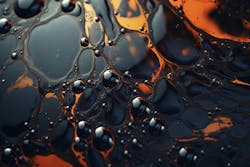Plant InSites: The Importance of Hot-Oil System Cleaning
A manufacturer was facing a vexing challenge with its wiped-film evaporators (WFEs) used to recover product from a waste stream. They were proving difficult to start up in low-temperature conditions (<60°F) conditions. The plant claimed that even at normal ambient temperatures startup was extremely challenging.
The first WFE operated at 10 mmHg absolute pressure, and the second at 5 mmHg absolute pressure. Both WFE units used the same high-temperature hot oil to vaporize the product at 800°F to 810°F. The operating temperature for both units was the same. Hot-oil temperature was varied, as the feed composition to the units changed.
Fouled Oil, Stressed System
The organic hot oil in use was a proprietary blend that was a slurry at roughly 60°F. While it did take special procedures for a cold startup it shouldn’t have been extremely difficult. One reason this fluid was selected was that it could operate at high temperatures and low pressures – keeping the overall plant cost down.
After discussing the available heat-transfer fluid options, I informed the client that without installing a completely new high-pressure hot-oil system and equipment, there was no viable alternative hot oil that would solve their issues.
This statement caused the operating superintendent to become extremely upset. He walked out of the room and then returned in a few moments with a black-gray tube about 2 ft. long and 3 in. diameter. Placing this on the table he said, “This is the problem; the hot oil won’t melt at room temperature.”
It took several moments to understand what I was looking at. At first, I thought it was a container of hot oil. But it wasn’t. It was a slug of what was supposed to be hot oil but was a solid instead. Indeed, it wasn’t a liquid at room temperature. However, it also wasn’t hot oil. It was so heavily contaminated with rust, scale, impurities and oxidation products that it was contaminants diluted with hot oil.
Don't Skip Evaporator Maintenance
Dirty oil is the result of thermal cracking, contaminants, corrosion and reactions (usually with oxygen). Dirty oil reduces heat transfer and creates operating problems.
When I asked the client about maintaining and cleaning the system, the client said the system was so difficult to keep fully clean that that they had essentially given up trying.
One issue with the plant’s system was the operating temperature of 800°F-810°F. The hot oil was even hotter. Additionally, the hot oil was heated by a gas-fired heater. Film temperatures of the hot oil in the heater were much higher.
In fact, the hot oil was operating in the range where thermal cracking and degradation was guaranteed. Additionally, the maintenance around hot-oil cleaning was occasionally allowing air into the system. The oxidation resulting from this was a major factor in the cold startup problems.
Both thermal cracking and oxidation are very temperature sensitive. Depending upon the organic system involved, the reaction rate for both doubles roughly every 15-35°F. While insufficient data were available to be 100% sure, it looked like both the cracking and oxidation in this specific system was doubling every 18°F.
Key Takeaways: Keep it Clean
Reducing the operating pressure in the WFE vaporizers to enable lower temperature operation was not a feasible option. The pressure was already so low that lowering it more would only change operating temperatures 1-2°F. Additionally, the lower operating pressures would dramatically reduce unit capacity.
Replacing the WFEs with an electrically heated unit was one conceivable solution, but an extremely expensive one.
In this case, the most practical short-term solution was to keep the hot oil clean. This involved extra filtration, nitrogen purges and more frequent purges of hot oil and make-up with fresh hot oil. Even with these changes, improvement was slow as the entire system had a large amount of contamination in the pipes and equipment that required cleaning and purging during operation.
This plant problem illustrates one key point with hot-oil systems. If a system is not working or not doing the job needed, the first question should always be “is the oil clean?” While systems should not require “perfect” oil to perform properly, just giving up and not doing required maintenance only hampers hot-oil system performance.
About the Author
Andrew Sloley, Plant InSites columnist
Contributing Editor
ANDREW SLOLEY is a Chemical Processing Contributing Editor.

